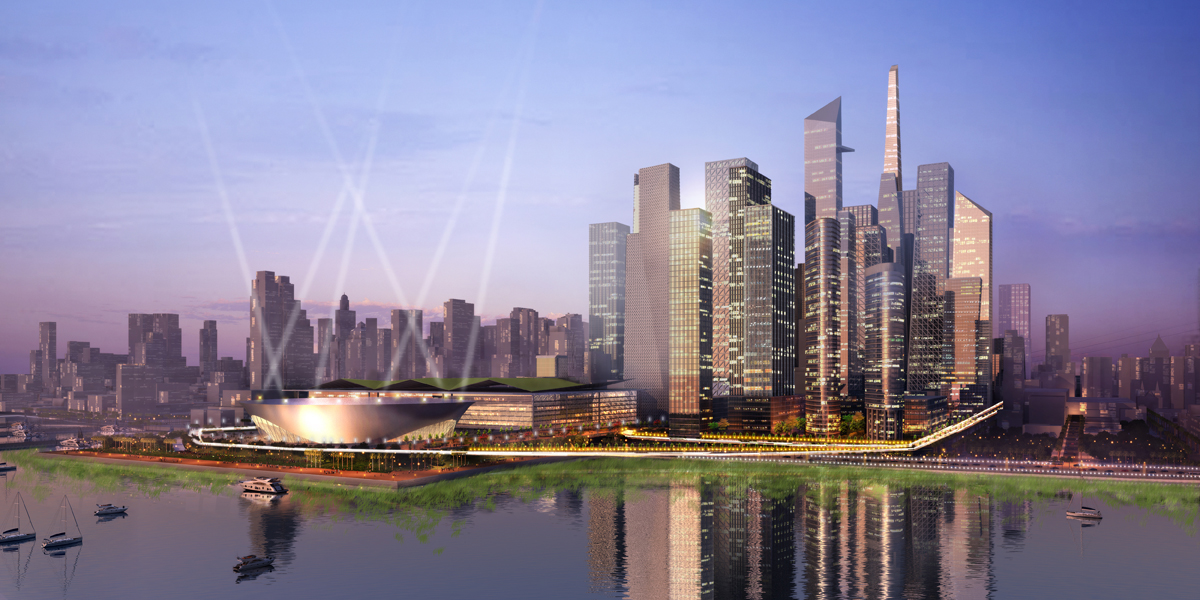by: Bill Millard
There may be only one proposition that every sentient being in the tri-state region would agree on: Penn Station, as we know, it has to go. As Margaret Newman, FAIA, noted at the “Transportation as Cultural Identifier: Penn 2023” on 04.19.14, the station was built under the twin erroneous assumptions that New York City and rail travel were both in conditions of irreversible decline. Penn Station is slightly smaller than Bryant Park – about 8½ acres, or 368,000 vs. 418,000 square feet – yet the number of people passing through it daily, reported Newman, is roughly equivalent to the population of Denver, some half a million. And pass through it is all most of them do: it is no place to linger, the opposite of a welcoming space, disliked as widely as its lamented predecessor was admired. As Chris Sharples, AIA, hardly needed to remind this audience, it is a place where “we use the word ‘flee’; Vincent Scully probably would use the word ‘scurry.’” “If you think it’s bad now,” added Thomas Wright of the Regional Plan Association (RPA), “you ain’t seen nothing yet,” considering the rising numbers of users at this confluence of multiple transit systems. (Some 80% of Manhattan’s entering commuters now come from west of the Hudson, feeding New Jersey Transit’s growth over the past two decades, with the Long Island Rail Road holding steady, and true high-speed rail for the Northeast Corridor a possibility.) Endure it though we all do, the situation is critical.
An irresistible force – the public interest in replacing the rodent-tunnels compressed beneath the “hatbox” of Madison Square Garden with a civic gateway of suitable scale, grandeur, and civility, not to mention firmness, commodiousness, and beauty – has just over nine years to overcome an immovable object. (The immovable object is, of course, the Garden, which received only a 10-year extension of its operating permit from City Council last year, not the indefinite extension desired by its owners the Dolan family, or the 15 years recommended by Mayor Bloomberg’s administration.) The Municipal Art Society and RPA have addressed this need in their 2013 report Penn 2023, which marshals the talents of four major firms – Skidmore, Owings & Merrill (SOM), Diller Scofidio + Renfro (DS+R), H3 Hardy Collaboration Architecture, and SHoP Architects) to envision new alternatives for the station, the Garden, and the neighborhood.
It is an opportunity for the kind of ambition that Hugh Hardy, FAIA, ardently hopes to see revived in New York, challenging all parties to think in appropriately Burnhamite terms: “It’s going to take every ounce of energy that we possess to make a change as large as what we’re talking about. The future of Penn Station actually is the future of Manhattan West. It requires a large, bold, complex, multiphase plan with support from the city,” as well as the state and federal government. “We should be so proud and committed to the fact that we can do big things here. Why can’t this generation do what others have? Why should we only admire the past?” Nostalgia for the 1910 McKim, Mead & White station and respect for Alexander Cassatt’s heroic efforts to get it built (appropriately commemorated in a recent PBS special) helped empower the city’s preservation movement. But those qualities now need to be matched by a comprehensive vision that can link the sorely needed transportation infrastructure (not only a new Penn and Moynihan Station, but the 7 line extension and the East Side Access project, giving the LIRR a Grand Central terminal at last) to the broader picture. This includes the rise of the High Line/Chelsea area, Hudson Yards, and the waterfront, shifting Midtown’s center of developmental gravity westward. The four firms’ suggestions range from pragmatic to utopian, with varying degrees of achievable programming and theoretical abstraction.
SOM’s Roger Duffy, FAIA, noted optimistically that certain aspects of the critical hard work have already been done, in part in Cassatt’s day: the tunneling and the electrification of trains, for starters, leaving the current generation to elaborate on those achievements. The SOM entry moves the pivotal chess piece of the Garden to a block of Eighth Avenue below the Farley Post Office (and projected Moynihan Station), with a dramatic oculus bringing light deep into a new Penn. H3 proposes a new Garden atop a 16-acre platform on the Hudson, connected back to the city by an elevated walkway. Clearing and upzoning a new Seventh Avenue commercial corridor adjacent to the new Penn, Hardy suggests, would help pay for the private/public endeavor. SHoP has its eyes on the Morgan postal-sorting site on West 30th a few blocks south of Farley, clearing the way for a brightly (neo-Caracallically?) sunlit Penn linked with the “civic necklace” of his firm’s Gotham Gateway, connecting the upper High Line with the new arena’s piano nobile. DS+R’s Ben Gilmartin, AIA – along with observing how the current arrangement implies that “the 95% of the population that use [Penn] today are prioritized less than the 5% who use Madison Square Garden” – offered a Penn with highly porous, parametrically-sculpted forms and a layered programming scheme that recognizes paradigm shifts in people’s use of time, locating the fastest movers (train riders) at the base level, with successively slower and more contemplative economic and cultural activities on higher strata. An associated smartphone app called a “time leash” would help integrate people’s shopping, dining, cultural, and other activities with the waiting periods associated with travel schedules; one hopes that by the time the Garden can move (in DS+R’s arrangement, to Ninth Avenue behind Farley) and the multifunction complex can be built, that entire 95% population will have affordable smartphones.
All four projections are necessarily visionary at this stage, with forms that Newman soberly termed “notional,” yet the nine-year ticking clock implies that they’ll need to assume physically, economically, and politically achievable forms soon. While calling for the necessary public/private cooperation – Wright looked wistfully at the local “legacy of management disasters” and at Hong Kong’s Mass Transit Railway, “a real estate operation that also runs trains,” as a model any American city can at best struggle to emulate – the participants acknowledged that the architectural community’s leadership needs political clout (preferably that of the governor, Duffy noted). A key question is whether the Dolans will play an obstructionist, extortionist, or purposeful role. Any new scheme has to make business sense for the Garden’s sports and entertainment operations; “if we do nothing,” Newman observed, “they will wait this out.” Anyone familiar with how the Garden and Cablevision operate might draw the most pessimistic of inferences. Then again, CEO James Dolan, after years of doing little about the Knicks’ performance besides singing about it with his blues band, recently hired Phil Jackson to oversee basketball operations. Sometimes, to paraphrase Churchill, people will eventually do the right thing after exhausting all the alternatives.
Bill Millard is a freelance writer and editor whose work has appeared in Oculus, Icon, The Architect’s Newspaper, and other publications.
Event: Transportation as Cultural Identifier: Penn 2023
Location: Center for Architecture, 04.09.2014
Speakers: William Menking, Founder and Editor-in Chief, The Architects’ Newspaper, and Professor of Architecture, Urbanism, and City Planning at Pratt Institute (moderator); Hugh Hardy, FAIA, Founder and Principal, H3 Hardy Collaboration Architecture; Chris Sharples, AIA, Principal, SHoP Architects; Roger Duffy, FAIA, Partner, SOM; Ben Gilmartin, AIA, Principal, Diller Scofidio + Renfro; Thomas Wright, Executive Director, Regional Plan Association; Margaret Newman, FAIA, Executive Director, Municipal Art Society
Organizers: AIANY Cultural Facilities Committee & AIANY Transportation and Infrastructure Committee












